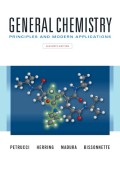
Concept explainers
(a)
Interpretation:
To determine the chemical equation for the production of lead carbonate.
Concept introduction:
A chemical equation refers to the symbolic representation of a given
(b)
Interpretation:
To determine the chemical equation for the production of lithium carbonate.
Concept introduction:
A chemical equation refers to the symbolic representation of a given chemical reaction in the form of formulae and symbols where the product entities are present on the right hand side of the chemical equation while the reactant entities are present on the left hand side of the chemical equation.
(c)
Interpretation:
To determine the chemical equation for the production of hydrogen peroxide.
Concept introduction:
A chemical equation refers to the symbolic representation of a given chemical reaction in the form of formulae and symbols where the product entities are present on the right hand side of the chemical equation while the reactant entities are present on the left hand side of the chemical equation.
(d)
Interpretation:
To determine the chemical equation for the production of lead (IV) oxide.
Concept introduction:
A chemical equation refers to the symbolic representation of a given chemical reaction in the form of formulae and symbols where the product entities are present on the right hand side of the chemical equation while the reactant entities are present on the left hand side of the chemical equation.
Want to see the full answer?
Check out a sample textbook solution
Chapter 21 Solutions
EBK GENERAL CHEMISTRY
- Look at the image attached pleaarrow_forwardComplete the mechanismarrow_forwardV Biological Macromolecules Drawing the Haworth projection of an aldose from its Fischer projection Draw a Haworth projection of a common cyclic form of this monosaccharide: H C=O HO H HO H H OH CH₂OH Explanation Check Click and drag to start drawing a structure. Xarrow_forward
- Complete the mechanismarrow_forwardComplete the mechanismarrow_forward8 00 6 = 10 10 Decide whether each of the molecules in the table below is stable, in the exact form in which it is drawn, at pH = 11. If you decide at least one molecule is not stable, then redraw one of the unstable molecules in its stable form below the table. (If more than unstable, you can pick any of them to redraw.) Check OH stable HO stable Ounstable unstable O OH stable unstable OH 80 F6 F5 stable Ounstable X Save For Later Sub 2025 McGraw Hill LLC. All Rights Reserved. Terms of Use | Privacy C ཀྭ་ A F7 매 F8 F9 4 F10arrow_forward
 Chemistry: Principles and ReactionsChemistryISBN:9781305079373Author:William L. Masterton, Cecile N. HurleyPublisher:Cengage Learning
Chemistry: Principles and ReactionsChemistryISBN:9781305079373Author:William L. Masterton, Cecile N. HurleyPublisher:Cengage Learning Chemistry by OpenStax (2015-05-04)ChemistryISBN:9781938168390Author:Klaus Theopold, Richard H Langley, Paul Flowers, William R. Robinson, Mark BlaserPublisher:OpenStax
Chemistry by OpenStax (2015-05-04)ChemistryISBN:9781938168390Author:Klaus Theopold, Richard H Langley, Paul Flowers, William R. Robinson, Mark BlaserPublisher:OpenStax ChemistryChemistryISBN:9781305957404Author:Steven S. Zumdahl, Susan A. Zumdahl, Donald J. DeCostePublisher:Cengage Learning
ChemistryChemistryISBN:9781305957404Author:Steven S. Zumdahl, Susan A. Zumdahl, Donald J. DeCostePublisher:Cengage Learning Chemistry: An Atoms First ApproachChemistryISBN:9781305079243Author:Steven S. Zumdahl, Susan A. ZumdahlPublisher:Cengage Learning
Chemistry: An Atoms First ApproachChemistryISBN:9781305079243Author:Steven S. Zumdahl, Susan A. ZumdahlPublisher:Cengage Learning Principles of Modern ChemistryChemistryISBN:9781305079113Author:David W. Oxtoby, H. Pat Gillis, Laurie J. ButlerPublisher:Cengage Learning
Principles of Modern ChemistryChemistryISBN:9781305079113Author:David W. Oxtoby, H. Pat Gillis, Laurie J. ButlerPublisher:Cengage Learning




